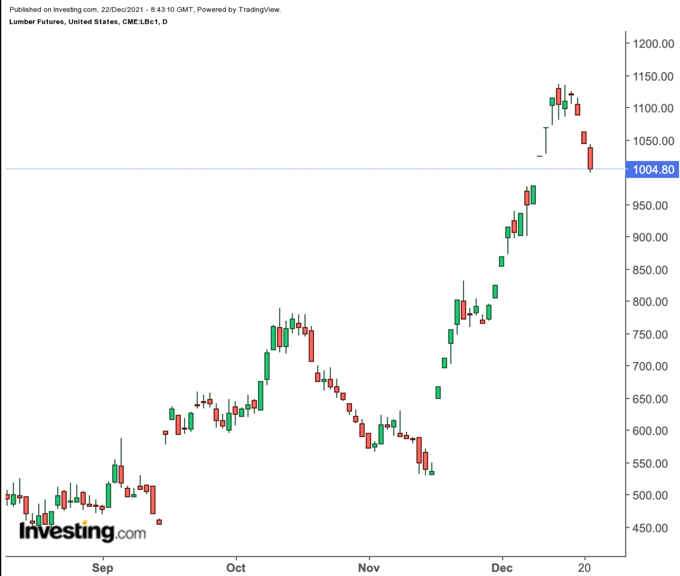After a 70% plunge from May’s record highs to under $500 in September, lumber futures have added back all that they shed over the past seven weeks, keeping up unrelenting pressure on US home prices into the new year.

US lumber for January delivery settled at just under $1,005 per 1,000-foot board in Tuesday’s trade. The price has risen 22% month-to-date, after a 40% jump in November and a net 25% climb from September through October.
In August, benchmark lumber prices were just under $450, after collapsing from May’s record highs of above $1,700.
At the current pace, lumber futures are set to finish 2021 up by 15%.
While the market is still some 40% below May’s peak, its clawing back of more than $400 in just seven weeks is reminiscent of the epic lumber rallies that ran for roughly a year from the spring of 2020. During that time, lumber futures went from a low of under $280 in March 2020 to the May 2021 peak of just above $1,710 amid the supply chain disruptions associated with the coronavirus pandemic.
While the Biden administration reports that output and logistics for commodities and other key materials have improved in recent months, the spike in lumber prices at least belies that notion.
More importantly, a renewed rally in lumber, the primary component for home frames in America, could have serious ramifications for US house prices which haven’t inched down through the pandemic due to inexorable demand from buyers in an extremely undersupplied market.
When lumber futures cratered between May and August—right after striking that record high above $1,710—Federal Reserve Chairman Jerome Powell used that as a basis for predicting in June that surging home costs and broader inflation will subside.
Neither did.
US home prices rose the most on record in the second quarter. The median price of an existing single-family home jumped 23% from a year earlier to an all-time high of $357,900, the National Association of Realtors said in a report in mid-August.
US consumer prices were up 6.8% in the year to November, for their fastest growth since 1982, as prices of almost everything have soared from the lows of the pandemic due to higher wage demands and supply chain disruptions. Producer prices jumped by a record 9.6% last month, year-on-year.
Under its mandate, the Fed is supposed to keep inflation at around 2% a year and raise rates if they go higher. The central bank has indicated it could have as many as three rate hikes in 2022, but there is no certainty yet on how effective that would be in clamping down on inflation in materials such as lumber or home prices.
The Wall Street Journal reported earlier this week that cash prices of lumber were on the way up too.
It quoted pricing service Random Lengths as saying that its framing composite index, which tracks on-the-spot sales, was up 65% since October, to $915. A $129 gain this week was the biggest on record, eclipsing a $124 jump in May, when lumber prices crested at all-time highs.
Building industry executives also told the Journal that they were confident of raising home prices further if lumber futures made another run higher.
“The market just feels really strong regarding pricing opportunities, so we’re comfortable,” said Ara Hovnanian, who sold homes for an average price of about $445,000 in the fiscal year ending Oct. 31, compared with roughly $419,000 a year earlier.
The National Association of Home Builders also seems to have its members covered in passing on to house buyers any undue cost spikes from lumber.
In the association’s advisory on lumber-related costs, sighted by Investing.com, the NAHB recommends that its members include “an escalation clause in contracts that indicates if lumber prices increase by a certain percentage, the customer would be required to pay the extra costs”.
Disclaimer: Barani Krishnan uses a range of views outside his own to bring diversity to his analysis of any market. For neutrality, he sometimes presents contrarian views and market variables. He does not hold a position in the commodities and securities he writes about.
